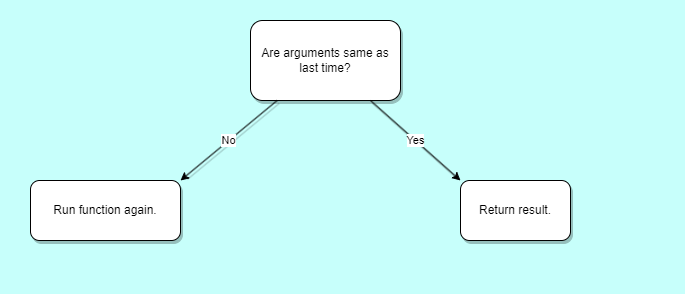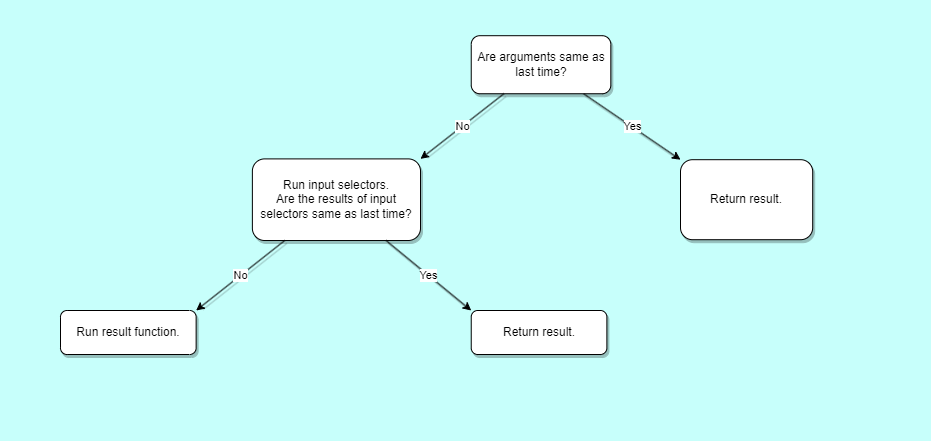How Does Reselect Work?
Reselect, at its core, is a library for creating memoized selectors in JavaScript applications. Its primary role is to efficiently compute derived data based on provided inputs. A key aspect of Reselect's internal mechanism is how it orchestrates the flow of arguments from the final selector to its constituent input selectors.
const finalSelector = (...args) => {
const extractedValues = inputSelectors.map(inputSelector =>
inputSelector(...args)
)
return resultFunc(...extractedValues)
}
In this pattern, the finalSelector is composed of several input selectors, all receiving the same arguments as the final selector. Each input selector processes its part of the data, and the results are then combined and further processed by the result function. Understanding this argument flow is crucial for appreciating how Reselect optimizes data computation and minimizes unnecessary recalculations.
Cascading Memoization
Reselect uses a two-stage "cascading" approach to memoizing functions:
The way Reselect works can be broken down into multiple parts:
-
Initial Run: On the first call, Reselect runs all the input selectors, gathers their results, and passes them to the result function.
-
Subsequent Runs: For subsequent calls, Reselect performs two levels of checks:
-
First Level: It compares the current arguments with the previous ones (done by
argsMemoize).-
If they're the same, it returns the cached result without running the input selectors or the result function.
-
If they differ, it proceeds ("cascades") to the second level.
-
-
Second Level: It runs the input selectors and compares their current results with the previous ones (done by
memoize).noteIf any one of the input selectors return a different result, all input selectors will recalculate.
- If the results are the same, it returns the cached result without running the result function.
- If the results differ, it runs the result function.
-
This behavior is what we call Cascading Memoization.
Reselect Vs Standard Memoization
Standard Memoization

Standard memoization only compares arguments. If they're the same, it returns the cached result.
Memoization with Reselect

Reselect adds a second layer of checks with the input selectors. This is crucial in Redux applications where state references change frequently.
A normal memoization function will compare the arguments, and if they are the same as last time, it will skip running the function and return the cached result. However, Reselect enhances this by introducing a second tier of checks via its input selectors. It's possible that the arguments passed to these input selectors may change, yet their results remain the same. When this occurs, Reselect avoids re-executing the result function, and returns the cached result.
This feature becomes crucial in Redux applications, where the state changes its reference anytime an action is dispatched.
The input selectors take the same arguments as the output selector.
Why Reselect Is Often Used With Redux
While Reselect can be used independently from Redux, it is a standard tool used in most Redux applications to help optimize calculations and UI updates:
Imagine you have a selector like this:
const selectCompletedTodos = (state: RootState) =>
state.todos.filter(todo => todo.completed === true)
So you decide to memoize it:
const selectCompletedTodos = someMemoizeFunction((state: RootState) =>
state.todos.filter(todo => todo.completed === true)
)
Then you update state.alerts:
store.dispatch(toggleRead(0))
Now when you call selectCompletedTodos, it re-runs, because we have effectively broken memoization.
selectCompletedTodos(store.getState())
// Will not run, and the cached result will be returned.
selectCompletedTodos(store.getState())
store.dispatch(toggleRead(0))
// It recalculates.
selectCompletedTodos(store.getState())
But why? selectCompletedTodos only needs to access state.todos, and has nothing to do with state.alerts, so why have we broken memoization? Well that's because in Redux anytime you make a change to the root state, it gets shallowly updated, which means its reference changes, therefore a normal memoization function will always fail the comparison check on the arguments.
But with Reselect, we can do something like this:
const selectCompletedTodos = createSelector(
[(state: RootState) => state.todos],
todos => todos.filter(todo => todo.completed === true)
)
And now we have achieved memoization:
selectCompletedTodos(store.getState())
// Will not run, and the cached result will be returned.
selectCompletedTodos(store.getState())
store.dispatch(toggleRead(0))
// The `input selectors` will run, but the `result function` is
// skipped and the cached result will be returned.
selectCompletedTodos(store.getState())
Even when the overall state changes, Reselect ensures efficient memoization through its unique approach. The result function doesn't re-run if the relevant part of the state (in this case state.todos), remains unchanged. This is due to Reselect's "Cascading Memoization". The first layer checks the entire state, and the second layer checks the results of the input selectors. If the first layer fails (due to a change in the overall state) but the second layer succeeds (because state.todos is unchanged), Reselect skips recalculating the result function. This dual-check mechanism makes Reselect particularly effective in Redux applications, ensuring computations are only done when truly necessary.